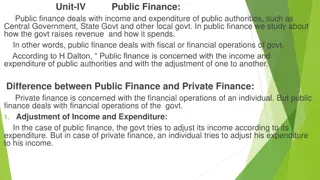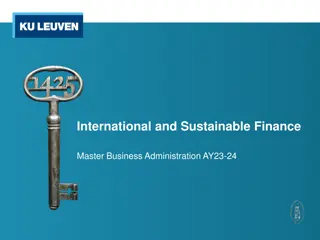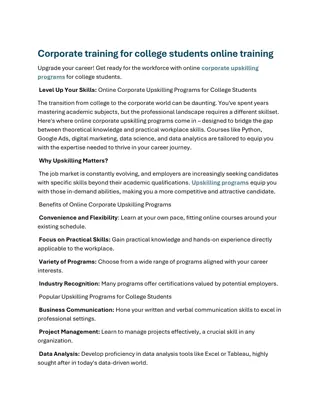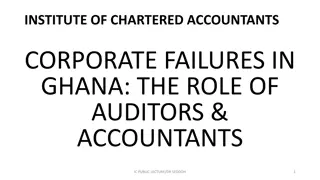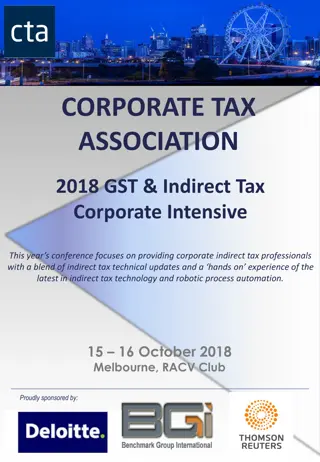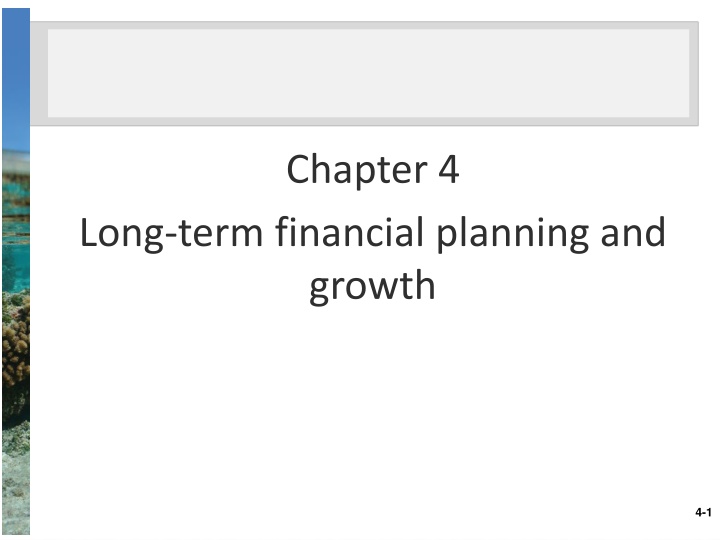
Long-Term Financial Planning and Growth Essentials
Explore the key concepts of long-term financial planning, including the percentage of sales method, external financing needs, determinants of growth, and challenges in planning for growth. Learn about financial planning models, elements, goals, and the importance of deriving inputs for effective planning.
Download Presentation

Please find below an Image/Link to download the presentation.
The content on the website is provided AS IS for your information and personal use only. It may not be sold, licensed, or shared on other websites without obtaining consent from the author. If you encounter any issues during the download, it is possible that the publisher has removed the file from their server.
You are allowed to download the files provided on this website for personal or commercial use, subject to the condition that they are used lawfully. All files are the property of their respective owners.
The content on the website is provided AS IS for your information and personal use only. It may not be sold, licensed, or shared on other websites without obtaining consent from the author.
E N D
Presentation Transcript
Chapter 4 Long-term financial planning and growth 4-1
LEARNING OBJECTIVES Apply the percentage of sales method Compute the external financing needed to fund a firm s growth Name the determinants of a firm s growth Anticipate some of the problems in planning for growth 4-2
CHAPTER OUTLINE What Is Financial Planning? Financial Planning Models: A First Look The Percentage of Sales Approach External Financing and Growth Some Caveats Regarding Financial Planning Models 4-3
ELEMENTS OF FINANCIAL PLANNING Financial planning establishes guidelines for change and growth in a firm Concerned with the major elements of a firm s financial and investment policies without examining the individual components of those policies in detail To develop an explicit financial plan, managers must establish certain basic elements of the firm s financial policy: The firm s needed investment in new assets The degree of financial leverage the firm chooses to employ The amount of cash the firm thinks is necessary and appropriate to pay shareholders The amount of liquidity and working capital the firm needs on an ongoing basis 4-4
WHAT IS FINANCIAL PLANNING? Financial planning formulates the way in which financial goals are to be achieved Growth, by itself, is not an appropriate goal Appropriate goal for a firm is increasing the market value of the owner s equity; if a firm is successful, growth will usually result Dimensions of financial planning Establishing the planning horizon, the long-range time period on which the financial planning process focuses (usually the next two to five years) Determine the level of aggregation, a process by which small investment proposals of each of a firm s operational units are added up and treated as one big project Derive inputs in the form of alternative sets of assumptions about important variables (e.g., worst, normal, and best case) 4-5
WHAT CAN PLANNING ACCOMPLISH? Examining interactions - Financial plan must make explicit the linkages between investment proposals for the different operating activities of the firm and its available financing choices Exploring options - Financial plan allows firm to develop, analyze, and compare many different scenarios in a consistent way Avoiding surprises - Financial planning should identify what may happen to the firm if different events take place Ensuring feasibility and internal consistency - Financial planning is a way of verifying that the goals and plans made for specific areas of a firm s operations are feasible and internally consistent Conclusion - Most important result of the planning process is that it forces managers to think about goals and establish priorities 4-6
FINANCIAL PLANNING MODELS: A FIRST LOOK Almost all financial models have these elements: Sales forecast Nearly all financial plans require an externally supplied sales forecast; often, the sales forecast will be given as the growth rate in sales Pro forma statements Financial plan will have a forecast balance sheet, income statement, and statement of cash flows; these are called pro forma statements, or pro formas Asset requirements Plan will describe projected capital spending and, at a minimum, the projected balance sheet will contain changes in total fixed assets and net working capital Financial requirements Plan will include a section about the necessary financing arrangements (e.g., dividend and debt policy) The plug The plug is the designated source(s) of external financing needed to deal with any shortfall (or surplus) in financing and thereby bring the balance sheet into balance Economic assumptions Plan will explicitly state the economic environment in which the firm expects to reside over plan s life 4-7
A SIMPLE FINANCIAL PLANNING MODEL Computerfield Corporation s financial statements from the most recent year are as follows: Suppose sales increase by 20%, rising from $1,000 to $1,200 Planners would then forecast a 20% increase in costs, from $800 to $960, and assume that all variables will grow by 20% 4-8
A SIMPLE FINANCIAL PLANNING MODEL (CONTINUED) Next step is to reconcile the two pro formas How, for example can net income be equal to $240 and equity increase by only $50? Compterfield must have paid out the difference of $240 50 = $190, possibly as a cash dividend, in which case dividends are the plug variable Suppose Compterfield does not pay out the $190 and the addition to retained earnings is the full $240 Equity will grow to $250 (the starting amount) plus $240 (net income), or $490, and debt must be retired to keep total assets equal to $600 With $600 in total assets and $490 in equity, debt will have to be $600 490 = $110, and because we started with $250 in debt, Compterfield will have to retire $250 110 = $140 in debt 4-9
PERCENTAGE OF SALES APPROACH In the simple financial planning model, every item increase at the same rate as sales This may be a reasonable assumption for some elements, but not for others (e.g., long-term borrowing) Extended version of simple model is examined next Basic idea is to separate the income statement and balance sheet accounts into two groups those that vary directly with sales and those that do not Based on the percentage of sales approach, a financial planning method in which accounts are varied depending on a firm s predicted sales levels 4-10
THE INCOME STATEMENT Rosengarten has projected a 25% increase in sales for the coming year, so we are anticipating sales of $1,250 To generate a pro forma income statement, we assume total costs will continue to run at $833/$1,000 = .833, or 83.3% of sales Effect of assuming that costs are a constant percentage of sales is to assume that the profit margin is constant Profit margin was $132/$1,000 = .132, or 13.2% In the pro forma, the profit margin is $165/$1,250 = .132, or 13.2% 4-11
THE INCOME STATEMENT (CONTINUED) Next, we need to project the dividend payment Assume Rosengarten has a policy of paying out a constant fraction of net income in the form of a cash dividend Dividend payout ratio is the amount of cash paid out to shareholders divided by net income, and Rosengarten s dividend payout ratio for the most recent year was this: Retention ratio, or plowback ratio, is the addition to retained earnings divided by net income (i.e., 1 - dividend payout ratio) Assuming dividend payout ratio is constant, here are the projected dividends and addition to retained earnings: 4-12
ROSENGARTEN CORPORATION BALANCE SHEET Rosengarten s most recent balance sheet is provided below: For items that vary with sales, we express each as a percentage of sales for the year just completed, whereas for items that do not vary directly with sales, we write n/a Ratio of total assets to sales is called the capital intensity ratio 4-13
ROSENGARTEN CORPORATION PARTIAL PRO FORMA BALANCE SHEET To construct a partial pro forma balance sheet, use percentages just calculated wherever possible to calculate the projected amounts, and for items that do not vary directly with sales, assume no change and write in the original amounts 4-14
A PARTICULAR SCENARIO Rosengarten has three possible sources for the $565 in new financing: short-term borrowing, long-term borrowing, and new equity Assume Rosengarten decides to borrow funds using a combination of short-term and long-term debt 4-15
AN ALTERNATIVE SCENARIO Capacity utilization can be a complicated question We effectively assumed Rosengarten was using its fixed assets at 100% capacity because any increase in sales led to an increase in fixed assets Assumption of 100% capacity utilization is not unrealistic for certain industries, but others have significant excess capacity If we assume Rosengarten is operating at only 70% of capacity (i.e., current sales level is 70% of the full-capacity sales level), the need for external funds is quite different Sales could increase by almost 43% - from $1,000 to $1,429 before any new fixed assets would be needed As a result, original estimate of $565 in external funds is too high, and we only need $565 450 = $115 in external funds 4-16
EXTERNAL FUNDS NEEDED (EFN) AND CAPACITY USAGE 4-17
GROWTH AND EXTERNAL FINANCING External financing needed and growth are related All other things staying the same, the higher the rate of growth in sales or assets, the greater will be the need for external financing Hoffman is forecasting next year s sales level at $600, a $100 increase Percentage increase in sales is $100/$500 = 20% We can prepare a pro forma income statement and balance sheet At a 20% growth rate, Hoffman needs $100 in new assets Projected addition to retained earnings is $52.8, so the external financing need (EFN) is $100 52.8 = $47.2 Debt-equity ratio for Hoffman is equal to $250/$250 = 1 Assume Hoffman does not wish to sell new equity, in which case the $47.2 in EFN will have to be borrowed Total owners equity is projected at $302.8, and the new total debt will be the original $250 plus $27.3 in new borrowing, or $297.2 total Debt-equity ratio thus falls from 1.0 to $297.2/$302.8 = 0.98 4-18
HOFFMAN COMPANY INCOME STATEMENT AND BALANCE SHEET 4-19
HOFFMAN COMPANY PRO FORMA INCOME STATEMENT AND BALANCE SHEET 4-20
GROWTH AND PROJECTED EFN FOR THE HOFFMAN COMPANY For relatively low growth rates, Hoffman will run a surplus, and its debt-equity ratio will decline Once the growth rate increases to about 10%, surplus becomes a deficit As the growth rate exceeds approximately 20%, the debt-equity ratio surpasses its original value of 1.0 4-21
THE INTERNAL GROWTH RATE Internal growth rate is the maximum growth rate a firm can achieve without external financing of any kind For Hoffman, net income was $66 and total assets were $500 ROA is thus $66/$500 = 0.132, or 13.2% Of the $66 net income, $44 was retained, so the plowback ratio, b, is $44/$66 = 2/3 Hoffman Company can expand at a maximum rate of 9.64% per year without external financing 4-22
THE SUSTAINABLE GROWTH RATE Sustainable growth rate is the maximum growth rate a firm can achieve without external equity financing while maintaining a constant debt-equity ratio For Hoffman, net income was $66 and total equity was $250 ROE is this $66/$250 = 0.264, or 26.4% Plowback ratio, b, is still 2/3, so we can calculate the sustainable growth rate as follows: Hoffman Company can expand at a maximum rate of 21.34% per year without external equity financing 4-23
DETERMINANTS OF GROWTH A firm s ability to sustain growth depends on the following factors: 1. Profit margin: An increase in profit margin will increase the firm s ability to generate funds internally and thereby increase its sustainable growth. 2. Dividend policy: A decrease in the percentage of net income paid out as dividends will increase the retention ratio. This increases internally generated equity and thus increases sustainable growth. 3. Financial policy: An increase in the debt-equity ratio increases the firm s financial leverage. Because this makes additional debt financing available, it increases the sustainable growth rate. 4. Total asset turnover: An increase in the firm s total asset turnover increases the sales generated for each dollar in assets. This decreases the firm s need for new assets as sales grow and thereby increases the sustainable growth rate. 4-24
SOME CAVEATS REGARDING FINANCIAL PLANNING MODELS Financial planning models do not always ask the right questions, primarily because they tend to rely on accounting relationships and not financial relationships The three basic elements of firm value tend to get left out: 1. Cash flow size 2. Risk 3. Timing Financial planning is an iterative process Plans are created, examined, and modified over and over Final plan will be a result negotiated between all the different parties to the process Financial plan will implicitly contain different goals in different areas and also satisfy many constrains 4-25
SELECTED CONCEPT QUESTIONS Why should firms draw up financial plans? What are the basic components of a financial plan? What is the basic idea behind the percentage of sales approach? What are the determinants of growth? What are some important elements that are often missing in financial planning models? 4-26
END OF CHAPTER CHAPTER 4 4-27



